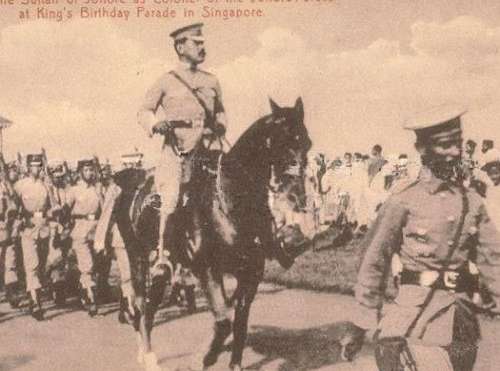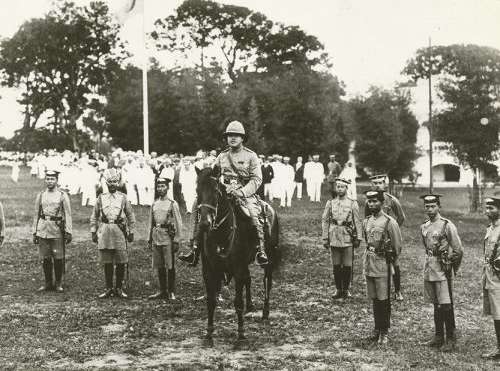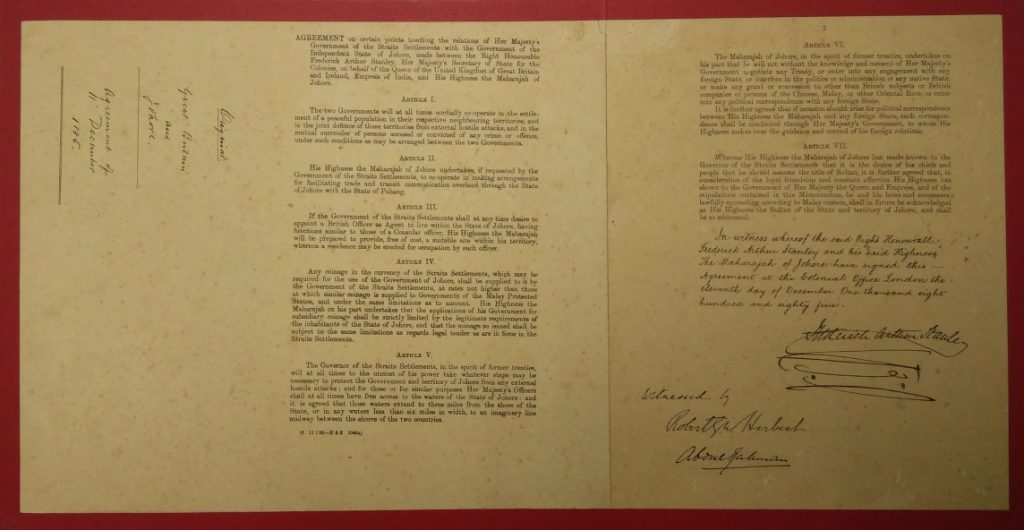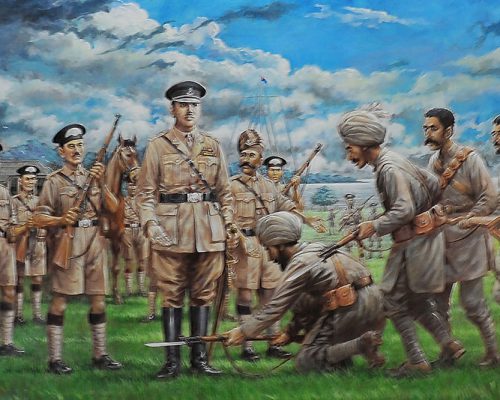

HISTORY
JMF ESTABLISHMENT
On December 11, 1885, Sultan Abu Bakar signed the Johor Government Agreement with Britain in London. In recognising Johor as an independent state, the British government acknowledged Abu Bakar and his heirs and successors, lawfully succeeding him as Sultan of the State and Territory of Johor.
Article 1 of the Agreement stipulates that the two governments shall at all times cordially cooperate in settlement of a peaceful population in their respective neighbouring territories and the joint defence of those territories from hostile external attacks.
The article states that the provision grants the Sultan Abu Bakar the authority to establish a military force. Prior to that, in 1855, Temenggong Ibrahim had formed a police force known as the Setia Troop to maintain security in Iskandar Puteri.
Sultan Abu Bakar realised that to ensure Johor’s independence and maintain peace and security, it was necessary to have a force to be reckoned with. He began recruiting a small military unit in the last few weeks of 1885 under the command of the Commissioner of Police Abdullah Tahir. Previously, Temenggong Daeng Ibrahim had formed a police constabulary known as Pasukan Setia (Loyal Force) in 1858 to provide security and maintain law and order in Iskandar Puteri. The constabulary was well armed and modern by the standard then and was tasked with military duties. Sultan Abu Bakar envisaged the new force to assist the police constabulary in dealing with any serious threat to internal law and order. He gave the name Askar Timbalan Setia Negeri Johor (ATSNJ), translated loosely as “army deputizing the police” to reflect that role, a name used until 1905 when Sultan Ibrahim changed it to the Johor Military Forces (JMF) to distinguish it from the Johor Volunteer Forces (JVF) that he founded in the same year. Askar Timbalan Setia Negeri Johor (ATSNJ).
The first batch of recruits consisted of 60 young Malays from the palace household, helmed by Syed Mohammad bin Nong Yahya. The Malay men were able to enforce law and order on other ethnicities but had trouble dealing with their own race, who did not fear them. Realising the situation, Sultan Abu Bakar recruited 20 Afghans known as Kabul, who had the aptitude for static and guard duties to assist the locals.
The increase in population forced Sultan Abu Bakar to change his strategy by adding Malay members and forming an infantry force. The Kabul members remained as palace guards. Sultan Abu Bakar added Kabul members with proficiency in artillery, forming an artillery force. Several years later, Sultan Abu Bakar established a brass band called the Johor Band. The name ATSNJ, which had 270 members in 1895, remained until 1905 when Sultan Ibrahim gave it the English name Johore Military Forces (JMF), differentiating it from the Johor Volunteer Forces (JVF) that His Majesty established in the same year.
In 1887, Sultan Abu Bakar appointed Captain C.N.C Newland of the 2ndnd Battalion South Irish Division, Royal Artillery, as instructor and commandant. Newland was noted for his intelligence and politeness, which helped boost the spirit and morale of the force.
His successor, Capt. F. de Vere Creighton, formerly head of the Siamese Military College, was of a different personality that contributed to the decline of the force. There were incidents of desertion as the men felt discriminated against, and their future was bleak. The numbers dwindled from 270 to 188. After Creighton, the JMF was administered by Captain Dato’ Daud bin Sulaiman.
The JMF contingents were deployed to all districts to assist the police. The Muar contingent, which included 12 Kabul artillerymen under the command of Engku Othman and Lt. Raja Ali, was placed at Fort Tanjong, where Sultan Abu Bakar’s palace was situated.

Loyalty Agreement Document signed by Sultan Abu Bakar on 11 December 1885
Sultan Ibrahim ascended the throne in 1895 with a keen and personal interest in the JMF. His leadership has been a decisive factor in bringing the forces to a state of efficiency that they present today. In 1901, on the advice of the Colonial Office, Sultan Ibrahim appointed Major (later Lt. Colonel) Arthur C. Tompkins of the Royal Fusiliers and Sargent Major (later Captain) Horace Cullimore of the Royal Marine Artillery to raise the standard of efficiency of the forces further. However, due to his obnoxious behaviour and inability to make progress.
Tompkin’s three-year contract was not extended. Cullimore was tasked to take over command. With the capability and assistance of Cullimore, the forces regained their glory. The acquisition of superior military equipment, better facilities for shooting practice, and joint exercises with British troops boosted the forces' morale.
After Cullimore, capable Malay officers were appointed as commanders and assisted by four British officers as advisors and trainers between 1928 and 1936.
In December 1915, Sultan Ibrahim codified the Johor Military Forces Enactment 18 of 1915 to enable the JMF to function as a legitimate military institution to implement policies and procedures on recruitments, terms of service, disciplinary guidelines, pension rules, regulations for honours and salutes, dress regulations and rules regarding custody. Salaries, allowances and conditions of service were also regulated. With better pay and living conditions, the JMF steadily grew in numbers and quality. English-educated candidates were especially attracted to join the force.
The JMF participated in two world wars as part of the obligations under the British 1885 Agreement.
Through the leadership of its officers and the efficiency and discipline of the JMF and JVF, the Indian Rebellion Army in Singapore was successfully suppressed, with the rebels eventually laying down their arms at the feet of the late Sultan Ibrahim.
As the sovereign military force for the state of Johor, each district and sub-district under the dominion of the Sultan of Johor is assigned contingents from the Royal Johor Military Force (JMF) and assisted by the Johor Volunteer Force (JVF). To date, the buildings serving as the Deputy State Secretary's offices are located in Pontian, Batu Pahat, Muar, Segamat, Kluang, Mersing, and Kota Tinggi. The deployment of JMF and JVF in these districts significantly impacts the security and stability of Johor, playing a crucial role in facilitating the visits of the Sultan of Johor and members of the royal family to these areas.
THE JMF DURING WORLD WAR 1
At the outbreak of the WW l in 1914, the JMF had 576 men and 86 Kabul artillerymen. As Colonel Commandant, Sultan Ibrahim deployed officers and men of the JMF to be stationed and performed duties at Woodlands, Keranji, Seletar, St. John’s Island and Belakang Mati Island in Singapore.
On February 15, 1915, together with India’s Fifth Light Infantry, 199 strong JMF men under the command of Captain Cullimore performed guard duties at Tanglin Barracks, where German citizens were held. Eight hundred Sepoys (Muslim soldiers of the Indian Army) mutinied as they were under the impression they would be sent to Europe and Turkey to fight Muslim soldiers there. But the discipline and bravery of the JMF, despite running low on ammunition, thwarted the mutiny. Unfortunately, Cullimore, Captain Abdul Jabbar bin Abdul Samad, and Private Yaacob bin Salleh were killed in the skirmish. When alerted the following day, Sultan Ibrahim led 150 men to Fort Canning after receiving news the mutineers would attack the British garrison there. The attack never materialised. Instead, the mutineers had made their way into Johor. Sultan Ibrahim and his men rushed back to Johor in hot pursuit of the mutineers. The JMF captured 180 mutineers, who were then escorted to the JMF headquarters, where they surrendered by placing their rifles, ammunition and bayonets at the feet of the unarmed Sultan Ibrahim and kissed his hand.

The Sepoy Mutineers surrendering and placing their rifles, ammunition and bayonets at the feet of the unarmed Sultan Ibrahim.
THE JMF DURING WORLD WAR 2
At the outbreak of WW ll, the JMF had 2000 men, making Sultan Ibrahim the head of the largest armed forces in Malaya. On the advice of the Johor government, Sultan Ibrahim assumed the rank of Major General of the expanded forces. Sultan Ibrahim and Major General Gordon Bennett of the Australian Imperial Forces planned a defensive strategy by deploying the JMF and Australian troops to defend the Kluang-Kahang-Mersing-Kota Tinggi line and to cover the airstrips at Tanjung Labuh and Kahang.
On 6th January 1942, two battalions of four companies of the JMF under the command of Lt. Colonel Musa bin Yusof were tasked to relieve Australian forces guarding communications installations at Kota Tinggi and establish a defence line along the river. When the Japanese bombed Johor Bahru and Kota Tinggi two weeks later, the GOC advised Sultan Ibrahim to disband the JMF as the Japanese army had poured into Malaya. The defence forces, not being strong enough to hold the invaders, were asked to retreat to Singapore. Initially reluctant, the Sultan agreed to the disbandment and insisted the men and their families return to their villages for safety. Sultan Ibrahim was quoted as saying the men did not like it but gave deference to him.
THE JMF AFTER WW 2
On the formation of the Malayan Union in 1946, the rulers, including the Sultan of Johor, were required to surrender their powers and prerogatives. The JMF ceased to function as a military unit. On July 31 of the same year, the officers and men of the JMF were discharged and granted five months full pay leave, retaining only a company of 100 men. The rank of Major General was deemed redundant, and the British appointed Sultan Ibrahim as an honorary Major General in the British Army.
The Federation of Malaya was formed on February 1, 1948. Under its constitution, the 100 men of the JMF were designated as the Sultan’s Own Bodyguards. This designation was met with fierce resistance from Sultan Ibrahim. The Federal government finally relented, and the JMF continued its existence and reorganised into a company of 128 men.
History repeated itself when, in August 1993, the Malaysian Parliament tabled a draft resolution, the Johor Military Forces (Disbandment and Repeal) Bill 1994, to disband the JMF as part of the government’s strategy to reduce the powers and privileges of the Johor Sultan. However, cool heads and reasoning prevailed, and the bill was withdrawn.
References:
- Dato’ Hj. Mohd. Said – Buku Treati Johor Dengan Pertambahan nya oleh Major Dato’ Mohammad Said 1941 dicetak oleh Lembaga Malaya Press Ltd. Johor Bahru 1925
- Dato’ Hj. Mohd. Said – A Compilation of Treaties and Agreements Affecting the State and Territory of Johor, The Government Printing Office Johor 1925
- Surat Perjanjian Kerajaan Johor 11 Disember 1885 (Perjanjian Setia)
- Dato’ Hj. Mohd. Said – Hikayat Johor Yang Kedua Tawarikh YMM Sultan Ibrahim 1941
- Tunku Shahriman bin Tunku Sulaiman – The Johor Military Forces The Oldest Army of Malaysian Regulars in the Peninsula JMBRAS Dec 2004
- Nesamalar Nadarajah – Johor and The Origins of British Control – Arena Book Sdn Bhd. 21 June 2000
- J.M. Gullick – Rulers and Residents Influence and Power in the Malay States 1870-1920, Oxford University Press 1992
- Shahrom Husain – Sejarah Johor Kaitan nya Dengan Negeri Melayu – Penerbit Fajar Sakti Sdn. Bhd. 1995
- Commemorative Book: 100 Years of the Royal Johor Military Force (JMF) 1886-1986, Johor Government Printer 1986.
- The Johor Military Forces Enactment No. 31, Johor Government Printer 1937
Unpublished:
- Opinion on the Proposal to Amend the Johor Constitution Consequent to the Passing of the Constitutional Amendment Act 1993 – Saleh Abas, Yaacob and Sofiah Advocates and Solicitors, 29 October 1993
- Yahya Ahmad – Johor Military Forces dan Kolonel Komandan Sultan Ibrahim, Satu Kajian Tinjauan Kemasyarakatan 1885- 1942, Thesis di Jabatan Sejarah Universiti Malaya 1974/75
- Pasukan Askar Timbalan Setia Negeri Johor – Talib Al-Da’a Johor Bahru 1952
- The Johor Military Forces (Disbandment and Repeal) Bill 1994, Dewan Rakyat 1994
Newspapers:
- The Straits Times July 28, 1902 – “The Johor Forces”
- The Straits Times November 17, 1948 – “When the JMF Were Disbanded”
- The Straits Times April 6, 1942 – “Mutineers Laid Their Guns at Sultan’s Feet”
- The Singapore Free Press September 16, 1955 – “When the Japs Came”
- The New Straits Times January 27, 1993 “Military Force Status Review at Exco Meeting”
- The New Straits Times August 14, 1993 – “End to Johor Military Forces. Muhyiddin: Sultan’s Private Army Will Be Disbanded.”

